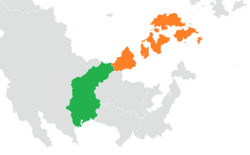Pulacan-Pulau Keramat relations: Difference between revisions
mNo edit summary |
|||
| Line 53: | Line 53: | ||
| '''Main religions''' | | '''Main religions''' | ||
| [[N'nhivara]] (33%) <br/> [[Asalism|Bulanan Asalism]] (31%) <br/> [[Azdarin|'Iifae Azdarin]] (8%) <br/> Margaya (5%) <br/> [[Asalism|Panonpoé Asalism]] (5%) <br/> Other (21%) | | [[N'nhivara]] (33%) <br/> [[Asalism|Bulanan Asalism]] (31%) <br/> [[Azdarin|'Iifae Azdarin]] (8%) <br/> Margaya (5%) <br/> [[Asalism|Panonpoé Asalism]] (5%) <br/> Other (21%) | ||
| [[Tlecoyanism|Tlaloc Ixtleconism]] (65%) <br/> [[N'nhivara]] (16%) <br/> [[White Path]] ( | | [[Tlecoyanism|Tlaloc Ixtleconism]] (65%) <br/> [[N'nhivara]] (16%) <br/> <br/> {{wp|Bantu_mythology|Indigenous animism}} (5%) <br/> [[White Path]] (4%) <br/> [[Azdarin]] (4%) <br/> [[Asalism]] (2%) <br/> Other (4%) | ||
|- | |- | ||
| '''GDP (nominal) (2020)''' | | '''GDP (nominal) (2020)''' | ||
Revision as of 08:22, 22 September 2022
This article is incomplete because it is pending further input from participants, or it is a work-in-progress by one author. Please comment on this article's talk page to share your input, comments and questions. Note: To contribute to this article, you may need to seek help from the author(s) of this page. |
Relations between the nations of Pulacan and Pulau Keramat are often reflective of the greater Kabaya'an ideology, with the two Malaio based nations having a long history of political, social, and economic interacation with one another.
 | |
Pulacan |
Pulau Keramat |
|---|---|
| Diplomatic mission | |
| Pulatec Embassy, Kopiona Poi | Pulaui Embassy, Mabesekwa |
| Envoy | |
| Ambassador Acnel Atonemac | Ambassador Korpore Pala |
Country comparison
| Populations | 83.5 million (2022) | 46.4 million (2020) |
| Area | 594,880 km2 | 749,856 km2 |
| Population density | 140.28/km2 | 61.93/km2 |
| Capital | Kopiona Poi | Yztac Tlalocan |
| Largest city | Tau Harimua | Tepetenxipaltlan |
| Government | Confederated oligarchical constitutional republic | Federal parliamentary constitutional republic |
| Current Leader | Dewan Emas Council (both head of state and government) |
President Coyotl Gontebanye head of state |
| Official languages | Birha, Mataram, Raji, Tuganani, Ahlranese | Setswana, Pulatec Nahuatl |
| Main religions | N'nhivara (33%) Bulanan Asalism (31%) 'Iifae Azdarin (8%) Margaya (5%) Panonpoé Asalism (5%) Other (21%) |
Tlaloc Ixtleconism (65%) N'nhivara (16%) Indigenous animism (5%) White Path (4%) Azdarin (4%) Asalism (2%) Other (4%) |
| GDP (nominal) (2020) | $1.9 trillion ($23,951 per capita) | $1 trillion ($21,712 per capita) |
| Military expenditures |
History
Modern-day Pulacan was peopled by various Komontu peoples from the 500s CE, with many fishing communities formed on the nation's Karaihe coastline. These communities grew thanks to the abundance of both seafood and trade goods accessible from the Karaihe and Ozeros Seas. Over the next five centuries, the northern communities began to form a separate identity from the wider Komontu diaspora, acting as trade mediaries between the central Djebe highland tribes and the maritime states of Malaio. The early stages of Pulaui-Pulatec relations is exemplified in the modern city of Mabesekwa, founded as X in the late 11th century CE as a joint trade outpost by the Pulaui-based Tahamaja Empire and a league of various merchant houses from the Tyresene city-states. The city quickly blossomed into a center of multicultural exchange, seeing ideas, goods and technology move to and from inland Pulacan, the Ozerosi region, and even the faraway Periclean Sea Basin.